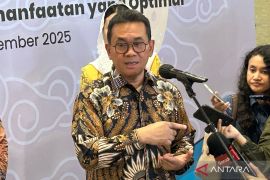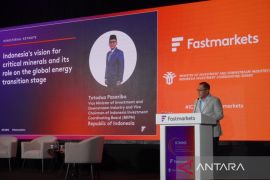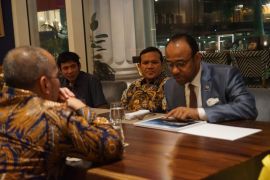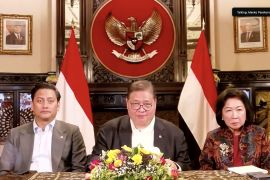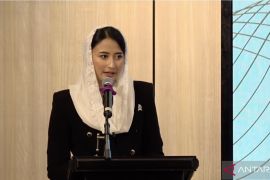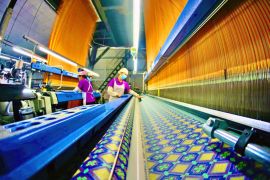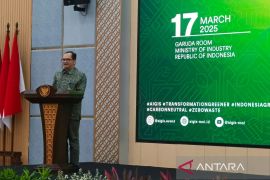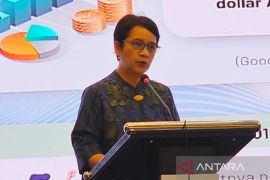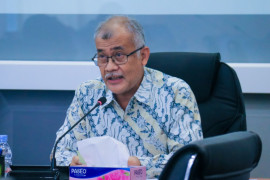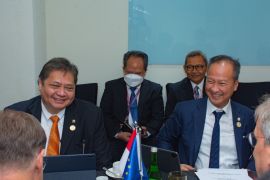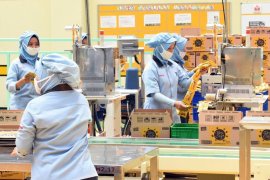According to Industry Minister Agus Gumiwang Kartasasmita, compared to other countries, the contribution of Indonesia's industry sector to the gross domestic product (GDP) has remained stable at 18–21 percent in the last decade.
Meanwhile, in other countries, such as India, Italy, Japan, Thailand, Vietnam, and Brazil, the sector's contribution has tended to fluctuate.
Further, the industry sector has made a high contribution to the sustainability of the national investment ecosystem, as reflected by the increase in investor interest.
From 2014 to 2016, investment reached Rp186.79 trillion (around USD11.76 billion), Rp232.02 trillion (around USD14.61 billion), and Rp322.92 trillion (around USD20.34 billion), respectively.
Meanwhile, from 2017 to 2019, the investment contribution of the non-oil and gas processing industry declined from Rp268.85 trillion (around USD16.94 billion) to Rp218.12 trillion (around USD13.74 billion), and then to Rp213.44 trillion (around USD13.44 billion).
However, the government made an appropriate and progressive response by issuing Law Number 11 of 2020 concerning Job Creation.
One of the main objectives of the law was to simplify doing business and thereby, increase investment interest in the non-oil and gas processing sector rapidly.
The Job Creation Law boosted investment in the non-oil and gas processing industry. Investment in the manufacturing sector rose again to Rp259.28 trillion (around USD16.33 billion) in 2020 and skyrocketed to Rp565.25 trillion (around USD35.61 billion) in 2023.
Considering the investment value in 2023, the non-oil and gas processing industry made a significant contribution of 39.84 percent to the total national investment value from all sectors of the economy.
The large contribution of the sector to the investment ecosystem directly made the industry a massive source of job creation.
The workforce absorption of the non-oil and gas processing industry stood at 13.8 percent in 2023. In addition, there has been an increase in jobs in the last 10 years, with 3 million new jobs created in the sector.
In terms of contribution to exports, the non-oil and gas processing industry's contribution was recorded to be relatively stable from 2014 to 2020, namely at around USD121 billion,
Then, in 2021, the figure rose significantly to USD176.73 billion and increased further to USD205.69 billion in 2022.
The high contribution was due to the effectiveness of the Operational Permit for Industrial Mobility and Activities (IOMKI) policy of the Ministry of Industry, which allowed Indonesia's manufacturing industry to tap into the export market.
In 2023, as productive industrial activities in many countries resumed after the COVID-19 pandemic, the industry's export contribution remained at a high level of USD186.59 billion.
With this, the non-oil and gas processing industry made the highest contribution to exports at 72.24 percent.
The large contribution in terms of investment, labor absorption, and export side of the manufacturing sector has strengthened the position of the Indonesian industry in the eyes of the international community.
Based on World Bank data, Indonesia was 12th among the world's "Top Manufacturing Countries by Value Added" in 2023, with economic value added from the manufacturing sector reaching USD255 billion.
Among Southeast Asian countries, Indonesia ranked first, above Thailand, which ranked second with USD128 billion, and Vietnam, which ranked third with USD102 billion.
Supportive policies
To maintain the contribution of the manufacturing sector to the advancement of Indonesia's economy, policies and regulations that prioritize industry are needed.
This is the main framework considered by the Ministry of Industry in preparing every policy.
At least seven policies implemented and one policy promoted by the ministry have had a major impact on industrial advancement.
The policies include strengthening industrial human resources through vocational education and training programs, the certain natural gas price policy (HGBT), the Making Indonesia 4.0 scheme, and the restructuring of industrial machinery/equipment.
They further include strengthening new small and medium industry entrepreneurs, decarbonization and green industry, the downstreaming policy, and encouraging the relocation of import product entry points to ports in eastern Indonesia.
For vocational education, the Ministry of Industry has set up nine vocational high schools, 11 polytechnics, and two community-based academies to create quality industrial human resources. The educational institutions are prioritizing meeting the needs of domestic industries.
The HGBT policy is a cheap gas subsidy, offering gas priced at USD6 per million British thermal units (MMBTU) to seven processing industry sub-sectors currently. They are fertilizers, petrochemicals, oleochemicals, steel, ceramics, glass, and rubber gloves.
The HGBT policy has greatly supported the advancement of the country's economy.
This is because, based on the portfolio of HGBT recipients in 2023, there were 321 companies with an industrial gas allocation of 1222.03 billion British thermal units per day (BBTUD), while the allocation for electricity was 1231.22 BBTUD.
The capital cost for the implementation of the HGBT program for the seven industrial sub-sectors was Rp51.04 trillion (around USD3.21 billion).
However, the added value generated from the program reached Rp157.20 trillion (around USD9.9 billion), or almost three times the initial capital disbursed.
Therefore, the Ministry of Industry is currently fighting to expand the scope of the HGBT policy to all industrial sub-sectors.
The next policy is the Making Indonesia 4.0 road map, which aims to combine digital and physical technologies to create a more efficient, flexible, and connected production system.
This is targeted at encouraging the productivity of domestic industry players so that they can make a greater contribution to the advancement of the national economy.
Meanwhile, under the industrial machinery/equipment restructuring program, financial assistance in the form of reimbursement is being provided to industry players who apply to renew their production machinery.
In the textile industry, the program has helped boost production capacity by 21.75 percent, energy efficiency by 11.68 percent, and sales by 6.65 percent.
In the wood processing industry, the program launched in 2022 has had a positive impact on increasing companies' efficiency by 10–30 percent, product quality by 10–30 percent, and productivity by 20–30 percent.
Meanwhile, the policy of strengthening new small and medium enterprise entrepreneurs is aimed at encouraging the emergence of new entrepreneurs with business legality.
As of 2024, the number of small and medium enterprises participating in the training reached 167,784 and those that have received business licenses stood at 64,490.
Furthermore, the decarbonization and green industry policies are intended to bolster the competitiveness of the industrial sector, considering that currently, the global market is demanding low-emission industrial products.
Since the issuance of the Industry Minister's Regulation Number 26 of 2018 concerning Green Industry Standards for the Portland Cement Industry, the cement industry has increased the reduction of greenhouse gas (GHG) emissions from energy, which, in 2022, reached 3.89 million tons of CO2.
It has also lowered the intensity of emissions from energy used in the production process.
Meanwhile, the downstreaming policy has brought great benefits to the metal and palm oil industries. Exports of the metal industry have moved in a positive direction since 2014. The highest exports were recorded in 2022, and they reflected a four-fold increase compared to 2014.
The number of standalone nickel smelters fostered by the Ministry of Industry that are already operating currently stands at 55. Their total production capacity is 26.98 million tons per year.
The downstreaming of nickel products has also contributed positively, as reflected by comparing the export values, which stood at USD1.06 billion in 2014 and reached USD6.82 billion in 2023. This means that downstreaming has brought about a six-fold increase in contribution.
The downstreaming of palm oil has brought significantly large benefits. This can be seen in the exports of the food industry from 2014, which tended to fluctuate slightly, but starting in 2020, they rose to reach a peak of USD48.46 billion in 2022.
The peak exports reflected a two-fold increase compared to 2014.
Meanwhile, investment in the food industry from 2014 showed some fluctuation, but rose by almost two-fold by 2022.
The variety of downstream products from palm oil also continued to increase from 48 types in 2011 to 193 types in 2023.
To maximize the role of the manufacturing industry in the advancement of the economy, synergy between ministries and agencies is needed for creating policies and regulations that support domestic industries.
This is necessary to realize the Asta Cita goals of President Prabowo Subianto and Vice President Gibran Rakabuming Raka who are seeking to make Indonesia a developed country.
Related news: Indonesia showcases industry capability with electric bicycle exports
Related news: ICA-CEPA to bolster Canadian investment in Indonesia: Kadin
Translator: Ahmad Muzdaffar, Raka Adji
Editor: Rahmad Nasution
Copyright © ANTARA 2024

